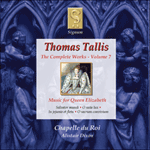
Welcome to Hyperion Records, an independent British classical label devoted to presenting high-quality recordings of music of all styles and from all periods from the twelfth century to the twenty-first.
Hyperion offers both CDs, and downloads in a number of formats. The site is also available in several languages.
Please use the dropdown buttons to set your preferred options, or use the checkbox to accept the defaults.

| Chapelle du Roi, Alistair Dixon (conductor)» More |
 PERFORMANCE
PERFORMANCE RECORDING
RECORDING

from notes by Andrew Carwood © 2015
extrait des notes rédigées par Andrew Carwood © 2015
Français: Hypérion
aus dem Begleittext von Andrew Carwood © 2015
Deutsch: Viola Scheffel
 Tallis: The Complete Works, Vol. 7 Tallis: The Complete Works, Vol. 7The present album is the seventh volume of a celebrated nine-disc series, presenting the Complete Works of Thomas Tallis (1505-1585). It presents Tallis’s Elizabethan Latin motets composed after the years of Reformation (and Elizabeth’s protestant ...» More |

